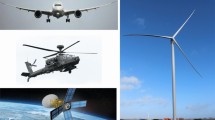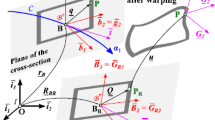Abstract
A number of sets of modes, for example eigenmodes, constraint modes, inertia-relief attachment modes, may be used to describe the linear elastic deformation of a flexible body in multibody dynamics. It is always possible to transform modes so that the conditions of the Buckens-frame are fulfilled. The latter frame leads to serious simplifications in the equations of motion, but cannot avoid a coupling between the body’s rotational rigid body motion and its elastic deformation. In the present paper the deformation modes will be subdivided into low- and high-frequency modes. It will be shown that the latter-mentioned coupling effect of the second ones can be safely neglected in comparison with the first ones. Consequently, the high-frequency components can be removed from time integration at all, which leads to significant savings of computational effort while the accuracy regarding the body’s deformation remains almost the same. In the case of a known frequency content of external excitation, an algorithm is given so that the available modes can be automatically separated into such low- and high-frequency modes. While the number of low-frequency modes remains more or less constant, there is a significant trend to use an increased number of high-frequency modes. Examples are moving loads (e.g., guidance) or distributed loads as they occur in contact problems or when fluid pressure is acting on surfaces. A final numerical example is given in order to demonstrate the potential of the proposed method.
Similar content being viewed by others
References
Agrawal O.P., Shabana A.A.: Dynamic analysis of multibody systems using component modes. Comput. Struct. 21(6), 1303–1312 (1985)
Ashley H.: Observations on the dynamic behavior of large flexible bodies in orbit. AIAA J. 5(3), 460–469 (1967)
Buckens, F.: The influence of elastic components on the attitude stability of a satellite. In: Proceedings of Fifth International Symposium on Space Technology and Sience, pp. 193–203. AGNE Publishers, Tokyo (1963)
Canavin J.R., Likins P.W.: Floating reference frames for flexible spacecraft. J. Spacecr. Rocket. 14(12), 724–732 (1977)
Castanier M.P., Tan Y.C., Pierre C.: Characteristic constraint modes for component mode synthesis. AIAA J. 39(6), 1182–1187 (2001)
Cavin R.K., Dusto A.R.: Hamilton’s principle: finite element methods and flexible body dynamics. AIAA J. 15(2), 1684–1690 (1977)
Craig R.R.: A review of time-domain and frequency-domain component mode synthesis methods. Int. J. Anal. Exp. Modal Anal. 2(2), 59–72 (1987)
Craig R.R., Bampton M.C.C.: Coupling of substructures for dynamic analyses. AIAA J. 6(7), 1313–1319 (1968)
Craig, R.R., Chang, C.J.: On the use of attachment modes in substructure coupling for dynamic analysis. In: Paper 77-045, Presented at AIAA/ASME 18th Structures, Structural Dynamics and Materials Conference, pp. 89–99. San Diego, CA, USA (1977)
Craig R.R., Kurdila A.J.: Fundamentals of Structural Dynamics. Wiley, New Jersey (2006)
Dietz, S., Wallrapp, O., Wiedemann, S.M.: Nodal vs. modal representation in flexible multibody dynamics. In: Multibody Dynamics 2003, International Conference on Advances in Computational Multibody Dynamics. Lisbon, Portugal (2003)
Escalona J.L., Valverde J., Mayo J., Domfnguez J.: Reference motion in deformable bodies under rigid body motion and vibration part I: theory. J. Sound Vib. 264(5), 1045–1056 (2003)
Friberg O.: A method for selecting deformation modes in flexible multibody dynamics. Int. J. Numer. Methods Eng. 32(8), 1637–1655 (1991)
Friberg O., Karhu V.: Use of mode orthogonalization and modal damping in flexible multibody dynamics. Finite Elem. Anal. Des. 7(1), 51–59 (1990)
Heirman G.H.K., Tamarozzi T., Desmet W.: Static modes switching for more efficient flexible multibody simulation. Int. J. Numer. Methods Eng. 87(11), 1025–1126 (2011)
Hurty W.C.: Dynamic analysis of structural systems using component modes. AIAA J. 3(4), 678–685 (1965)
Irschik, H., Nader, M., Stangl, M., von Garssen, H.G.: A floating frame-of-reference formulation for deformable rotors using the properties of free elastic vibration modes. In: Proceedings ASME 2009 International Design Engineering Technical Conferences and Computers and Information in Engineering Conference. ASME, San Diego, CA, US (2009). DETC2009-86660
Koppens, W.P.: The dynamics of systems of deformable bodies. PhD Thesis, Technical University of Eindhoven, Eindhoven, The Netherlands (1989)
Korn A.: Über die Eigenschwingungen eines elastischen Körpers bei verschwindenden Druckkomponenten an der Oberfläche. Palermo Rend. 30, 153–184 (1910)
Likins P.W.: Modal method for analysis of free rotations of spacecraft. AIAA J. 5(7), 1304–1308 (1976)
MacNeal R.H.: A hybrid method of component mode synthesis. J. Comput. Struct. 1(4), 581–601 (1971)
Mayo J.M., Garcia-Vallejo D., Domfnguez J.: Study of the geometric stiffening effect: comparison of different formulations. J. Multibody Syst. Dyn. 11, 321–341 (2004)
Negrut D., Ottarsson G., Rampalli R., Sajdak A.: On an implementation of the Hilber-Hughes-Taylor method in the context of index 3 differential-algebraic equations of multibody. J. Comput. Nonlinear Dyn. 2(1), 73–85 (2007)
Rubin S.: Improved component-mode representation for structural dynamic analysis. AIAA J. 13(8), 995–1006 (1975)
Schwertassek R., Wallrapp O.: Dynamik Flexibler Mehrkörpersysteme. Vieweg Verlagsgesellschaft, Braunschweig/ Wiesbaden (1999)
Shabana A.A.: Automated analysis of constrained inertia-variant flexible systems. ASME J. Vib. Acoust. Stress Reliab. Des. 107(4), 431–440 (1985)
Shabana A.A.: Resonance conditions and deformable body co-ordinate systems. J. Sound Vib. 192(1), 389–398 (1996)
Shabana A.A.: Flexible multibody dynamics: review of past and recent developments. J. Multibody Syst. Dyn. 1(2), 189–222 (1997)
Shabana A.A.: Dynamics of Multibody Systems, 3rd edn. Cambridge University Press, New York (2005)
Sherif, K., Irschik, H., Witteveen, W.: Transformation of arbitrary elastic mode shapes into Pseudo-free-surface and rigid body modes for multibody dynamic systems. J. Comput. Nonlinear Dyn. 7(2) (2012). http://dx.doi.org/10.1115/1.4005237
Sherif, K., Witteveen, W., Holl, H., Irschik, H., Mayrhofer, K.: Effiziente Berechnung von Kontaktproblemen mit lokalen Ritz-Ansatzvektoren. In: Proceedings of Neunte Internationale Tagugung: Schwingungen in Rotierenden Maschinen (SIRM 2011). Institute of Structural Dynamics, Technische Universität St Darmstadt, Darmstadt, Germany (2011)
Sherif, K., Witteveen, W., Irschik, H., Holl, H., Mayrhofer, K.: On the extension of global vibration modes with Ritz-vectors needed for local effects. In: Proulx, T. (ed.) Linking Models and Experiments, vol. 2. Proceedings of the 29th IMAC, A Conference on Structural Dynamics 2011, vol. 4, pp. 37–46. Society of Experimental Mechanics Inc., Springer New York, Jacksonville, FL, USA (2011)
Tran D.M.: Component mode synthesis methods using interface modes. Application to structures with cyclic symmetry. Comput. Struct. 79, 209–222 (2001)
Wasfy T.M., Noor A.K.: Computational strategies for flexible multibody systems. ASME Appl. Mech. Rev. 56(6), 553–613 (2003)
Wielenga T.J.: Simplifications in the simulation of mechanisms containing flexible members. PhD Thesis, The University Michigan, Michigan (1984)
Witteveen, W., Irschik, H.: Efficient computation of joint interface modes. In: Proceedings of the 27th International Modal Analysis Conference (IMAC-XXVII). Society of Experimental Mechanics Inc., Orlando, FL, USA (2009)
Witteveen W., Irschik H.: Efficient mode-based computational approach for jointed structures: joint interface modes. AIAA J. 47(1), 252–263 (2009)
Yeh H.F., Dopker B.: Deformation mode selection and mode orthonormalization for flexible multibody system dynamics. Comput. Struct. 34(4), 615–627 (1990)
Zienkiewicz O.C.: Introductory Lectures on the Finite Element Method. Springer, Wien, New York (1973)
Author information
Authors and Affiliations
Corresponding author
Rights and permissions
About this article
Cite this article
Sherif, K., Witteveen, W. & Mayrhofer, K. Quasi-static consideration of high-frequency modes for more efficient flexible multibody simulations. Acta Mech 223, 1285–1305 (2012). https://doi.org/10.1007/s00707-012-0624-1
Received:
Revised:
Published:
Issue Date:
DOI: https://doi.org/10.1007/s00707-012-0624-1




